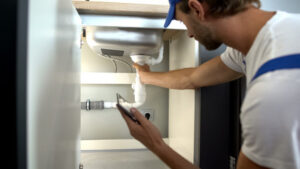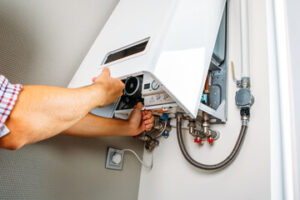Water Filtration Atlanta is a crucial step in the process of treating your tap water. It helps to remove sediment and other pollutants that can damage your plumbing or cause bad taste and odors.
Filters are available in many different forms, from bottled water to at-home filters. Each type works differently, so it’s important to read the label carefully to understand what contaminants each filter is certified to reduce.
Reverse Osmosis

Reverse osmosis water filtration is one of the most advanced forms of home water treatment available. Its powerful technology makes it possible to remove most dissolved solids, such as sodium and chloride, from drinking water. This makes it safe for drinking and cooking. In addition, it helps remove dangerous bacteria and other pathogens that can cause illness.
Reverse Osmosis uses a semi-permeable membrane to filter contaminants on a molecular level. This process separates water from dissolved salts and minerals, making it clean and healthy for drinking. It can also remove organic contaminants, such as viruses and bacteria, and unpleasant odours and tastes. The membrane is made of cellulose acetate, polysulfonate, or polyamide. It is typically surrounded by a pre-filter that removes large particles from the water. This step prevents the build-up of contaminants on the membrane surface and extends the lifespan of the RO membrane.
The reverse osmosis system is designed to treat city water and private well water. It is capable of reducing total dissolved solids (TDS) in city water up to 95%. It also reduces calcium carbonate and hardness in well water up to 98%. Reverse Osmosis is very expensive to install and requires regular maintenance to keep the membranes working properly.
A reverse osmosis system works by forcing pressurized water through a series of filters and membranes. The resulting pure water is stored in a storage tank until it is needed for cooking or drinking. The system can be installed under your sink, and the piping is usually run to the kitchen faucet. The first stage in the system is a polypropylene spun sediment filter, which eliminates most visible particulate. This step reduces the number of pollutants that will clog the RO membranes and carbon filters.
Reverse osmosis is a great option for homeowners who want to improve the taste and quality of their drinking water. However, before you invest in a reverse osmosis system, you should purchase a water test kit and get a clear picture of the TDS in your water. In order to make sure you have the right TDS for your coffee, you should try to get a reading around 150ppm. This is a good amount of TDS for high-quality specialty coffee.
Activated Carbon
Activated carbon is a porous material that acts like a sponge for different gases. It can be used to remove harmful chemicals, such as chlorine and organic solvents, from water. However, it is important to understand that activated carbon is not a substitute for disinfection. Disinfection will not destroy all bacteria and viruses in your tap water, so you still need to use a filter to remove them. The best way to do this is to use a multi-stage water filter that will reduce the levels of these contaminants in your drinking water.
Depending on the application, activated carbon can be used in two ways: as a stand-alone system or in conjunction with other water treatment systems. Granular activated carbon (GAC) is available in a wide range of sizes, pore structures, and substrates. It can be purchased at a very affordable price and is extremely effective. It can be impregnated with various chemicals to increase its adsorption capacity for specific molecules.
GACs are typically sorted by their ability to absorb vapor and liquid chemicals. The most efficient GACs are those with a high molasses number and low pore size. Molasses numbers are an indication of the mesopore content of the carbon, which is important for adsorption of large molecules. They are also a good indicator of the performance of the carbon against vapor.
The adsorption capacity of GACs is affected by a variety of factors, including molecular weight and concentration of the chemical being treated. It is also important to consider the operating conditions of the system. For example, the temperature of the water, the presence of other chemicals in the stream, and the polarity of the chemicals being removed will all affect the life expectancy of the GAC.
The most common application of activated carbon is to treat PFAS/PFOS (Perfluorooctane Sulfonic Acids) from drinking water. These are synthetic chemicals that were once widely used in fire-fighting foam, metal plating and stain repellents but have now found their way into drinking water sources all over the world. Currently, there are several major incidents of contaminated drinking water in North America and Europe that have been linked to these chemicals. Activated carbon can remove 30-70% of PFAS/PFOS from tap water, but this does not necessarily eliminate them completely.
NSF-certified
NSF-certified water filters meet specific public health standards that protect the quality and safety of drinking water. The certification process is rigorous, testing over 60 parameters across material safety and structural integrity. It also includes a physical evaluation of manufacturing facilities and processes, as well as full supply chain transparency. Only products that pass this rigorous testing can receive the NSF seal. This is an important step to ensuring that your water filter will actually do what it claims to do.
NSF is an independent organization that develops and maintains public health standards for food, water, consumer products and the environment. It has been developing these standards for over 75 years and is a leading world authority in the field. Its certification program is one of the most rigorous and transparent in the industry. Its strict certification requirements include the use of BPA-free plastics, rigorous tests for contaminant removal, and comprehensive evaluation of manufacturing facilities and processes.
A NSF certification means that the product has met the minimum requirements set by NSF International. The NSF standards cover a wide range of issues, from material safety to structural integrity to contaminant reduction. In addition, NSF-certified products are independently tested and evaluated to ensure that they meet all of the certifying criteria.
Choosing a NSF-certified water filter is an easy way to ensure that you are getting the best possible filtration system for your needs. NSF-certified water filtration systems are typically made from materials that are BPA-free and free of harmful chemicals, such as bisphenol A (BPA). They are designed to be durable and long-lasting, and they are backed by extensive third-party testing and certifications.
The NSF-certified water filtration system you choose depends on the specific contaminants that you want to remove from your drinking water. For example, some NSF-certified filters are certified to reduce up to 15 different contaminants, including prescription drugs and over-the-counter medications like ibuprofen and naproxen, herbicides, pesticides and more. They also reduce perfluorooctanoic acid (PFOA) and perfluorooctane sulfonate (PFSA), which are used in nonstick cookware, fire retardant coatings and more.
Cost
Water filtration systems remove unwanted contaminants from your home’s tap water to make it safer and healthier. They also help improve the taste and smell of your water, reduce stains on clothes and dishes, and protect appliances from mineral buildup and corrosion. However, the cost of a water filter can vary widely depending on the type and size of the system. Some systems are more complex than others, and therefore, more expensive to install and maintain. In addition, some filtration systems require extra plumbing work to install properly, which will increase the overall costs of installation.
The most common way to filter water is through a carbon-based system. This method works by reducing unpleasant tastes and odors through absorption, which occurs when water passes through the carbon’s large surface area. These surfaces are packed with tiny nooks and crannies that trap chemical impurities such as chlorine. Some filters even include ion exchange materials to trap heavy metals such as lead and mercury.
Another way to filter water is through distillation. This process involves boiling the water and then capturing the condensed steam. This removes most of the chemicals and minerals in the water, making it cleaner and safer to drink. However, it does not remove all of the chemicals and minerals, so you should be cautious when using this method.
A water filtration system can range in price from $100 to $500. Higher-end models with more advanced features and higher contaminant removal capabilities are typically more expensive. However, you should remember that the initial investment will pay off in the long run as you’ll spend less on costly repairs and replacements.
Investing in a home water filtration system can save you money in the long run by protecting your appliances, improving the taste and smell of your drinking water, and ensuring that your water is free from harmful bacteria. Additionally, it will extend the life of your appliances and reduce repair costs by removing minerals from them.
Water filtration systems are available in many different forms, from whole house to individual point-of-use units that can be installed under sink, on countertops, or in pitchers. A comprehensive system will address all the issues that are present in your home’s water. This will likely be more expensive than a standalone system.


